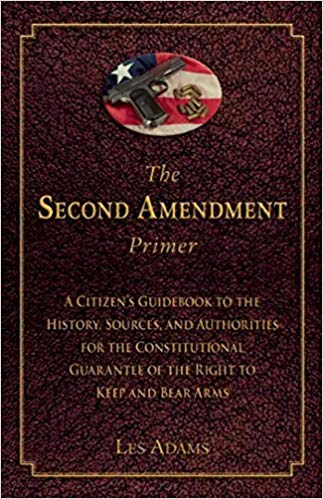
No matter what your politics are, you can only intelligently agree or disagree with something if you know what you’re talking about. Weighing in with an uneducated opinion helps no one.
And, whether we like it or not, the Second Amendment is at the core of our gun rights. Understanding it is a requirement for developing a knowledgeable view of gun rights and how we may proceed with those rights.
The Second Amendment Primer: A Citizen’s Guidebook to the History, Sources, and Authorities for the Constitutional Guarantee of the Right to Keep and Bear Arms by Les Adams is an excellent piece of literature for educating yourself on the Second Amendment. But, it’s not a perfect example of a perfectly unbiased source of Second Amendment information.
We’ll get to that. First, here’s a look at what this book does really well.
.
Second Amendment History
The right to bear arms didn’t start in America. One of the best things about this book is that it reaches back beyond the formation of the United States for information that supports the right to keep and bear arms.
Greek and Roman wisdom, English Common Law, and other sources are drawn upon for insight into why the Second Amendment was written and why it’s a cornerstone of the United States Constitution.
The author references a number of opinions of non-Americans. The experiences of people as varied as Alan Dershowitz and Mahatma Gandhi are included, which broadens the scope beyond the usual examination of Nazi Germany or Fascist Italy.
Events like the lesser known actions of the British Empire and other governments are brought in to show what might have influenced the founding fathers to consider the Second Amendment a necessity in the Constitution.
This approach is refreshing because it demonstrates the context around the Second Amendment. Often, studies of the Second Amendment adhere doggedly to the constitutional text, which makes it difficult to understand the right to bear arms as a natural right. This book gets us out of America, to demonstrate that the concept of the right to bear arms didn’t arise de novo at the Philadelphia Convention.
Language
The Second Amendment Primer does leverage one of the most powerful pieces of literature for understanding the Second Amendment: the United States Constitution.
Adams examines the language of the other constitutional amendments to establish how the author, James Madison, spoke and used language at the time. From there, he examines the Second Amendment through a more objective lens, within the context of what words meant at the time the Constitution was written.
Then, this contextual analysis is combined with contemporary Supreme Court decisions to demonstrate why the original language is still relevant and applicable today.
This presents the Second Amendment very objectively, free of secondary interpretations and confusion caused by the evolution of English.
Supplemental Literature
There are three additional essays in the appendix. These essays aren’t mere extensions of the information in the book or supporting evidence. The essays heavily expand on the issue of what the Second Amendment protects.
Where The Second Amendment primer focuses on the Second Amendment itself, the included essays demonstrate what risks being lost in the Second Amendment debate. These essays are an excellent study in how small adjustments to the right to bear arms right now could take us well down the road toward nullification of it.
Jeff Snyder’s essay, “A Nation of Cowards” adds a discussion about the nature of violence, as it relates to the Second Amendment and the natural right to self-defense.
Should You Read This Book?
In short, yes.
If you have any interest in constitutional law, the Second Amendment debate, or if you just want a better understanding of the Second Amendment, this is a great book.
The Second Amendment Primer is not a book for lawyers. It provides a basic education for those interested in the relevant constitutional law. Supreme Court decisions and modern court cases are covered. But the main thrust of this book is the individual right to bear arms. This book is a decent starting point for law students. But there’ll be a lot more follow-up reading to do.
Also, this book was published some years ago. So, there are some important recent court cases which are not covered.
Nor is this an unbiased read (but what book about the Second Amendment is?). The author’s pro-rights bias is certainly evident.
So, this may not be the best recommendation for someone looking for a purely impartial approach, let alone someone who’s hopelessly anti-gun. But is an excellent choice for anyone open to historical information that clarifies the thinking behind the Second Amendment.
Adams’ objective information is easy to separate from his opinions, too, if you are paying attention. There’s plenty to learn from his book, even if you’re a seasoned student of the Second Amendment.
.
.

—Jay Chambers is a Texas business owner, archer, shooter and survivalist. He believes in free speech, resiliency and self-sufficiency in an increasingly unpredictable world.
